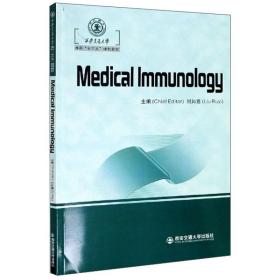
医学免疫学(英文版)
全新正版未拆封
¥ 24.46 4.2折 ¥ 58 全新
仅1件
四川成都
认证卖家担保交易快速发货售后保障
作者刘如意 编
出版社西安交通大学出版社
出版时间2020-08
上书时间2024-05-03
- 最新上架
商品详情
- 品相描述:全新
图书标准信息
- 作者 刘如意 编
- 出版社 西安交通大学出版社
- 出版时间 2020-08
- ISBN 9787569315080
- 定价 58.00元
- 装帧 其他
- 开本 其他
- 【内容简介】
- 《医学免疫学(英文版)》为临床医学专业基础主干课程,主要学习引起免疫应答的抗原的特性、种类,执行免疫应答的免疫系统包括免疫器官、免疫细胞、免疫分子的结构与功能,免疫应答的种类和机制,运用免疫学原理进行免疫学预防、诊断及治疗(包括免疫学检测与免疫学防治)。学习并实践免疫学基本实验原理、方法及技能。《医学免疫学(英文版)》为我校本科“十三五”规划教材第二批建设项目,是医学专业留学生的必选教材,也是国内学生实用的参考教材。
- 【目录】
-
Chapter 1 Introduction
1. Basic Concept of Immunity
2. Basic Functions of the Immune System
3. The Type of Immune Response
4. Brief History of Immunology
Chapter 2 General Introduction to Immune System
1. Central Immune Organs
2. Peripheral Immune Organs
3. Lymphocytes and Recirculation
4. Immune Molecules
Chapter 3 Immunogens & Antigens
1. Antigen
2. Factors Affecting Antigen Immunogenicity
3. Antigen Classification
4. Important Antigens in Medicine
5. Non-Specific Stimulates
6. Superantigen
7. Adjuvants
Chapter 4 Immunoglobulin & Antibody
1. Concept
2. Immunoglobulin Structure
3. Function Domains
4. Enzymatic Digestion Fragments of Ig
5. Isotypes, A11otypes & Idiotypes
6. Characteristics and Functions of Various Immunoglobulins
7. Functions of Antibodies
8. Production of Antibody
Chapter 5 Complement
1. Nomenclature and Components
2. Pathways of Complement Activation
3. Regulation of the Complement System
4. Complement Effects
5. Clinical Aspects
Chapter 6 Cytokine
1. Nomenclature of Cytokines
2. Cytokine Families
3. General Characteristics of Cytokines
4. Cytokine Receptor Families
5. Cytokine Treatment
6. Overview & Prospect
Chapter 7 Major Histocompatibility Complex
1. Genetic Organization of the MHC
2. Structure of the MHC Gene Products
3. Functions of MHC Molecules
Chapter 8 Cells of the Innate Immune System
1. The Mono Nuclear Phagocyte System
2. Natural Killer Cells
3. Dendritic Cells
Chapter 9 B and T Lymphocytes
1. Overview of Lymphocyte Development
2. Antigen Receptor Gene Rearrangement and Expression
3. B Lymphocyte Development
4. T Lymphocyte Development
Chapter 10 Antigen-Presenting Cells and Antigen Presentation
1. Antigen Capture and the Functions of Antigen-Presenting Cells
2. Processing of Protein Antigen
3. Physiologic Significance of MHC-Associated Antigen Presentation
4. Presentation of Non-Protein Antigens to Subsets of T Cells
Chapter 11 Humoral Immunity
1. Overview of Humora] Immune Responses
2. Antigen Recognition and Antigen-Induced B Cell Activation
3. The Germinal Center Reaction
4. Antibody Responses to T-Independent Antigens
Chapter 12 T Cell-Mediated Immunity
1. Activation, Differentiation and Functions of CD4 ~ TH Cells
2. Activation and Function of CD8 + Tc Cells
3. Biological Effects of Cellular Immunity
4. The Final Fate of Effector T Cells
Chapter 13 Immunity to Infection
1. Immunity to Bacteria
2. Immunity to Virus
Chapter 14 Hypersensitivity
1. Definition and Classification
2. IgE-Mediated Type I Hypersensitivity: Allergy
3. Type II-Cytotoxic Hypersensitivity
4. Type III-Immune Complex Hypersensitivity
5. Type IV-Delayed-Type Hypersensitivity
Chapter 15 Immunological Tolerance
1. Central Tolerance
2. Peripheral Tolerance
3. Acquired Tolerance
Chapter 16 Autoimmunity and Autoimmune Disease
1. Tolerance
2. Spectrum of Autoimmune Diseases
3. Autoimmune Diseases
Chapter 17 Immunodeficiency
1. Primary Immunodeficiency
2. Secondary Immunodeficiency
Chapter 18 Tumor Immunity
1. Tumor-Associated Antigens (TAAs) And Tumor-Specific Antigens (TSAs or TSTAs)
2. Mechanism of Tumor Immunity
3. Evasion of Immune Responses by Tumors
4. Immunotherapy for Tumors
Chapter 19 Transplantation and Rejection
1. The Transplantation Problem
2. Transplantation Antigens
3. Rejection Mechanisms
4. Prevention of Graft Rejection
Chapter 20 Immunological Techniques
1. Methods of Detection Antigen-Antibody (Serologic Reaction)
2. Detection of Cellular Immune Function
Chapter 21 Immunoprophylaxis and Immunotherapy
1. Immunoprophylaxis
2. Immunotherapy
References
点击展开
点击收起
相关推荐
— 没有更多了 —



















以下为对购买帮助不大的评价